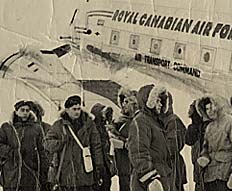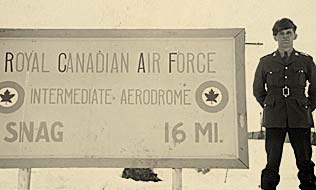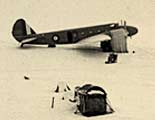The Route and the Royal Canadian Air Force - RCAF
Group of military men wearing parkas, winter boots and mitts standing beside an open-doored RCAF Douglas C-47 "Dakota" plane. ca. 1979. (view more details)

From 1939 to September 1942, the federal Department of Transport controlled operations of the Northwest Staging Route. In 1942, it was handed over to the Royal Canadian Air Force because the route was being used predominantly for military purposes. In June 1944, the Northwest Air Command was formed to take over complete operations of the route with headquarters in Edmonton. The Yukon section of the Northwest Air Command was RCAF Station Whitehorse, with detachments at Teslin, Aishihik, and Snag; in 1946 the unit at Watson Lake was added.
RCAF Twin Beech 18 "Expeditor" airplane that flew daily to Teslin from Whitehorse with mail and supplies. Members of RCAF Teslin posing in front of the aircraft in Teslin, ca. 1944...There were about 15 members stationed there.
(view more details)

The RCAF also participated in the campaign to rid the Aleutian Islands of the Japanese task force which had attacked Dutch Harbour in June 1942. The Japanese had established bases on the islands Kiska and Attu. The U.S. Air Force asked the Canadians for air support and they responded by sending one squadron to Alaska right away. In 1943 another two squadrons were sent.
One of the airfields on the Northwest Staging Route was at Snag. It was closed in 1968... (view more details)

After World War II, the RCAF controlled the airports along the staging routes, provided planes in Whitehorse ready for search and rescue operations, and transported people, freight and mail for the Dominion of Canada. RCAF Station Whitehorse continued to function primarily as a refueling point to Alaska. During the Korean War many aircraft flew this route on their way to Japan. The RCAF also controlled a large-scale trucking operation supplying all the RCAF stations and airports along the Alaska Highway between Dawson Creek and Snag. In 1947, a Winter Experimental Establishment was set up at Edmonton with advanced bases at Watson Lake and Churchill. This Establishment provided guidance in the design of new equipment for cold weather use and in improving existing technology. The RCAF carried out tests for Canadian forces as well as British and American air forces.
The Department of Transport took over the operation and maintenance of the airport facilities at Whitehorse in 1958. The RCAF’s function changed to primarily a Radio Unit, specializing in communications, which in 1966 became a unit of the Canadian Forces Supplementary Radio System. RCAF Station Whitehorse was renamed CFS Whitehorse at that time. In 1968, CFS Whitehorse was disbanded, ending a presence of almost 30 years in the Yukon.


